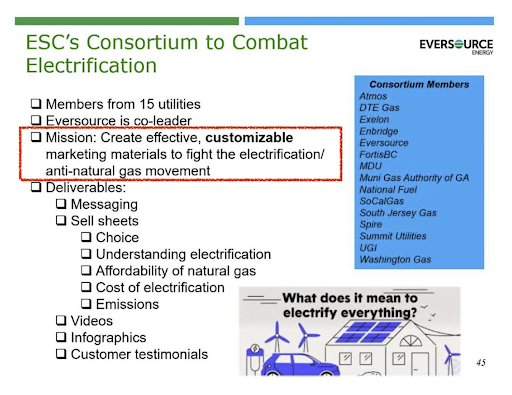Articles Menu

Jan. 26, 2022
Across North America, jurisdictions are starting to ban gas from new buildings as part of plans to tackle the climate emergency. And that has fossil fuel gas companies very nervous and pushing back. FortisBC, the primary provider of “natural” gas to British Columbia homes and businesses, sensing an impending existential threat to their business plan has a counter-plan.
In many cities, well over 50 per cent of carbon pollution comes from burning “natural” gas in buildings, so action to get our buildings off gas can have a huge climate impact, as well as a positive health impact. The City of Vancouver already has a new regulation in place that, effective this year, prohibits new buildings from using fossil fuels for space and water heating. Other municipalities want to follow suit. Pressure is mounting on the provincial government from climate-concerned organizations and citizens to simplify and expedite this trend by making it a provincewide policy to ban new buildings from tying into gas lines.
All of which has Fortis scrambling, desperate to figure out how to end-run these climate plans and continue to expand its customer base.
The company’s latest mischief-making? On Jan. 20, FortisBC announced it is bringing a proposal to the BC Utilities Commission (the provincial energy regulator) to supply all new homes with 100 per cent “renewable gas” — at no extra cost to these future customers.
In a “North American first,” declared the company, “every newly constructed home connecting to the gas system would automatically receive 100 per cent renewable gas for the lifespan of the building. The approval of this proposal would mark a new era in the evolution of the company's renewable energy programs.”
Wow, sounds fantastic. Well, not so fast.
The pledge to provide new buildings with 100 per cent renewable gas is a fiction, an imaginary and arbitrary assignment. And the company’s desire to provide this renewable gas at no extra cost to new customers — meaning, to bury the actual high expense of producing renewable gas by spreading it across all ratepayers — likely stems from Fortis’s desire to hide the true cost of renewable gas for as long as possible. Its real cost would certainly make the choice of electric more appealing.
Fortis’s recent news release also touts plans to increase the overall share of renewable natural gas in its system, and makes the brash claim, “The use of renewable natural gas eliminates any need for expensive building retrofits to fuel switch.” This is an outrageous statement that lays bare the company’s real end-game here — to get around the new climate regulations of cities like Vancouver and forestall households swapping to electric heat pumps for the sake of the climate.
First, let’s be clear about what renewable gas is. Renewable natural gas (RNG) is methane captured from organic waste — landfills, sewage, agricultural waste — and then purified so it can be added to the gas line system. The benefit of RNG is that, in the absence of this capture, this methane would simply be released into the atmosphere.
But when Fortis talks about “renewable gas,” it isn’t speaking only of RNG, it is employing a broader definition that also dubiously includes, among other things, blending in hydrogen (what kind Fortis doesn’t say, but much of it may indeed be fossil fuel-derived), the scale of which remains unknown.
'We can’t afford to be tricked into fictional solutions or be lured by false promises. The emergency is too real, the urgency too great,' writes columnist @SethDKlein. #Climate Crisis #FortisBC #RNG Twitter
Second, much of the public has the impression that if they purchase RNG, or Fortis pledges that their building will be supplied “100 per cent by renewable gas,” the gas that enters their home is somehow cleaner — they believe they have done better for the environment. No such luck.
There are no separate gas lines for renewable gas. Fortis is not assigning “renewable” gas molecules to specific dwellings. Rather, all the renewable gas produced or purchased by Fortis enters the same gas line system like all the rest of the fracked gas burned in our homes. Fortis may wish to claim that new buildings will be supplied 100 per cent with renewable gas, but it’s a deceit — under its plan, the gas that enters a new home will be no different from the gas that enters an older home next door.
The real question is how much RNG Fortis can manage to put into the overall system.
CleanBC, the province’s official climate plan, has a target — to which FortisBC has agreed — that 15 per cent of BC’s gas supply will be RNG by 2030, although this has yet to be embedded in regulation. It is merely an aspirational target.
Fortis claims, “The company is currently on pace to exceed its target of having 15 per cent of its gas supply being renewable by 2030 and is working towards having about 75 per cent of its supply be renewable by 2050.”
That’s a highly speculative pledge, not to mention extremely expensive to achieve. For now, consider it a fanciful pipe dream — an assertion plucked from the air.
Currently, only about one per cent of the gas supplied by Fortis is renewable (as a company rep recently confirmed to CBC radio after some prodding). True, there are a number of new renewable gas projects in the works, and that share is escalating at a solid clip. But at this point, even the 15 per cent target remains notional.
There is absolutely no assurance that Fortis can meet the more ambitious renewable gas targets it is now bandying about. Indeed, there is good reason to hope such supply goals cannot be met. Large-scale growth in RNG hinges on the continuation and expansion of our wasteful consumption habits. It assumes we as a society will continue to produce an endless supply of agricultural and household waste from which “renewable” methane can be captured. For all our sakes, we should hope that assumption is wrong.
Alternatively, Fortis may presume that much of that 75 per cent target will be met by means of hydrogen production, but that technology is far from ready, it may be derived from fossil fuels, and it presents Fortis with another challenge, which is that the current gas piping cannot handle too much hydrogen.
There are numerous other reasons electrification is a better approach to zero-emission buildings than renewable gas.
First, unlike with gas (renewable or otherwise), electric heat pumps provide cooling in the summer, a side benefit that will only become increasingly vital for human health and survival in an era of global heating. Indeed, if new buildings continue to heat with gas, those new owners will likely, in time, additionally invest in separate air conditioners, a poor use of energy and money when a heat pump system could have provided an all-in-one solution.
Second, RNG is still methane, and there are compelling health and safety reasons we should seek to get this gas out of our homes. No need for carbon monoxide detectors or to worry about what your kids are breathing when your home heating and cooking is electric.
And arguably most importantly, as we shift our society to carbon-zero, there are a few sectors and industrial activities that, for various reasons, cannot electrify, and which consequently will genuinely need the limited supply of RNG we can produce. Buildings — especially new buildings — are not among them. We do indeed need to capture the methane released from our waste. But that source should hopefully be limited, and the captured gas should be well and thoughtfully deployed.
The gas companies are relentless in defence of their growth plans. I’ve written previously about all the ways FortisBC tries to discourage electrification — offering rebates for new high-efficiency gas furnaces, hot water heaters and fireplaces; writing letters to customers discouraging fuel-swapping to electric; paying for “energy specialists” on staff with municipalities.
More recently, it’s come to light that Fortis is making mischief in B.C.’s schools. The company has an extensive package of lesson plans — a so-called "Energy Leaders K-12 curriculum" — it has made “freely” available to school districts (meaning, paid by Fortis ratepayers) for which over 2,000 teachers have already registered. Thankfully, the Canadian Association of Physicians for the Environment and other health professionals have begun an organized push to get this fossil fuel company’s resources out of our schools.
To be clear, FortisBC is not alone in such efforts. They are rife among the gas companies. As the leaked slide below shows, FortisBC and Enbridge (the largest provider of natural gas in Canada, servicing mainly Ontario and Quebec) are both members of a North American Consortium to Combat Electrification, an alliance of 15 gas companies across the continent that seeks to block gas bans and for which the push for “renewable” natural gas figures centrally in its collective strategy (as the consortium slide linked to here reveals).

In Ontario, Enbridge Gas has found a dependable ally in the government of Doug Ford. As the CBC reports, rather than seeking to limit gas from new building developments, the Ontario government is doing the opposite — “building new natural gas heating infrastructure to serve more customers and communities, including some that have been relying on electric heat until now. And it's making existing customers subsidize that expansion.”
Fortis could choose a different path. It could seek to truly reinvent itself as a new generation energy company, focusing on electric heat (as the company does in other provinces), and on neighbourhood geothermal and heat exchange systems where its expertise would be welcome. Instead, like much of the fossil fuel industry, the company is choosing to double down on gas.
We can’t afford to be tricked into fictional solutions or be lured by false promises. The emergency is too real, the urgency too great. Jurisdictions moving quickly to get gas out of buildings are showing important leadership that will result in significant GHG reductions.
Perhaps with this latest move, Fortis has overplayed its hand. Consider this the last desperate gasp of a dying industry. The province should take Fortis out of its misery (and the rest of us), refuse its request to the BC Utilities Commission, and move expeditiously to regulate a provincewide ban on new gas tie-ins for buildings.
[Top photo: The pledge to provide new buildings with 100 per cent renewable gas is a pipe dream, writes columnist Seth Klein. Photo by Niklas Eichler / Pexels]